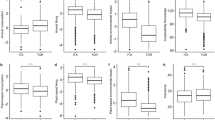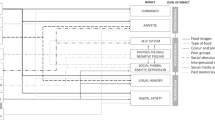Abstract
Adolescents are exposed to extensive marketing for junk food, which drives overconsumption by creating positive emotional associations with junk food1,2,3,4,5,6. Here we counter this influence with an intervention that frames manipulative food marketing as incompatible with important adolescent values, including social justice and autonomy from adult control. In a preregistered, longitudinal, randomized, controlled field experiment, we show that this framing intervention reduces boys’ and girls’ implicit positive associations with junk food marketing and substantially improves boys’ daily dietary choices in the school cafeteria. Both of these effects were sustained for at least three months. These findings suggest that reframing unhealthy dietary choices as incompatible with important values could be a low-cost, scalable solution to producing lasting, internalized change in adolescents’ dietary attitudes and choices.
This is a preview of subscription content, access via your institution
Access options
Access Nature and 54 other Nature Portfolio journals
Get Nature+, our best-value online-access subscription
$29.99 / 30 days
cancel any time
Subscribe to this journal
Receive 12 digital issues and online access to articles
$119.00 per year
only $9.92 per issue
Buy this article
- Purchase on Springer Link
- Instant access to full article PDF
Prices may be subject to local taxes which are calculated during checkout


Similar content being viewed by others
Data availability
The data that support the findings of this study are available on request from the Population Research Center at the University of Texas at Austin. Researchers must agree to the terms of data use, including analysis on a secure server and prohibitions against any analysis that risks exposing the identity of the participating students (that is, deductive disclosure). Requests for data should be directed to E. Johnson at ejohnson@prc.utexas.edu.
Code availability
The syntax used to produce all of the results reported in this article is available at https://osf.io/2wuh3/.
References
Kessler, D. A. The End of Overeating: Taking Control of the Insatiable American Appetite (Rodale Books, 2009).
Moss, M. Salt, Sugar, Fat: How the Food Giants Hooked Us (Random House, 2013).
Nestle, M. Food marketing and childhood obesity—a matter of policy. N. Engl. J. Med. 354, 2527–2529 (2006).
Hastings, G. & Cairns, G. in Preventing Childhood Obesity: Evidence Policy and Practice 120–128 (Wiley-Blackwell, 2010).
Harris, J. L., Pomeranz, J. L., Lobstein, T. & Brownell, K. D. A crisis in the marketplace: how food marketing contributes to childhood obesity and what can be done. Annu. Rev. Public Health 30, 211–225 (2009).
Swinburn, B. A. et al. The global obesity pandemic: shaped by global drivers and local environments. Lancet 378, 804–814 (2011).
Forouzanfar, M. H. et al. Global, regional, and national comparative risk assessment of 79 behavioural, environmental and occupational, and metabolic risks or clusters of risks in 188 countries, 1990–2013: a systematic analysis for the Global Burden of Disease Study 2013. Lancet 386, 2287–2323 (2015).
Gakidou, E. et al. Global, regional, and national comparative risk assessment of 84 behavioural, environmental and occupational, and metabolic risks or clusters of risks, 1990–2016: a systematic analysis for the Global Burden of Disease Study 2016. Lancet 390, 1345–1422 (2017).
Kleinert, S. & Horton, R. Rethinking and reframing obesity. Lancet 385, 2326–2328 (2015).
Wang, Y. C., McPherson, K., Marsh, T., Gortmaker, S. L. & Brown, M. Health and economic burden of the projected obesity trends in the USA and the UK. Lancet 378, 815–825 (2011).
Bailey, R. Evaluating calorie intake. Data Science Campus https://datasciencecampus.ons.gov.uk/eclipse/(2018).
NCHS Nutrition Data https://www.cdc.gov/nchs/data/factsheets/factsheet_nutrition.htm (National Center for Health Statistics, 2013)..
Rose, G. Sick individuals and sick populations. Int. J. Epidemiol. 30, 427–432 (1985).
Rose, G. The Strategy of Preventive Medicine (Oxford Univ. Press, 1992).
Kobes, A., Kretschmer, T., Timmerman, G. & Schreuder, P. Interventions aimed at preventing and reducing overweight/obesity among children and adolescents: a meta-synthesis. Obes. Rev. 19, 1065–1079 (2018).
Dahl, R. E., Allen, N. B., Wilbrecht, L. & Suleiman, A. B. Importance of investing in adolescence from a developmental science perspective. Nature 554, 441–450 (2018).
Bryan, C. J. et al. Harnessing adolescent values to motivate healthier eating. Proc. Natl Acad. Sci. USA 113, 10830–10835 (2016).
Stice, E., Shaw, H. & Marti, C. N. A meta-analytic review of obesity prevention programs for children and adolescents: the skinny on interventions that work. Psychol. Bull. 132, 667–691 (2006).
Steinberg, L. How to improve the health of American adolescents. Perspect. Psychol. Sci. 10, 711–715 (2015).
Ainslie, G. Specious reward: a behavioral theory of impulsiveness and impulse control. Psychol. Bull. 82, 463–496 (1975).
Vansteenkiste, M., Simons, J., Lens, W., Sheldon, K. M. & Deci, E. L. Motivating learning, performance, and persistence: the synergistic effects of intrinsic goal contents and autonomy-supportive contexts. J. Pers. Soc. Psychol. 87, 246–260 (2004).
Lee, K. H., Siegle, G. J., Dahl, R. E., Hooley, J. M. & Silk, J. S. Neural responses to maternal criticism in healthy youth. Soc. Cogn. Affect. Neurosci 10, 902–912 (2014).
Damon, W., Menon, J. & Bronk, K. C. The development of purpose during adolescence. Appl. Dev. Sci. 7, 119–128 (2003).
Robinson, T. N. Save the world, prevent obesity: piggybacking on existing social and ideological movements. Obesity 18, 17–22 (2010).
Telzer, E. H., Fuligni, A. J., Lieberman, M. D. & Galván, A. Neural sensitivity to eudaimonic and hedonic rewards differentially predict adolescent depressive symptoms over time. Proc. Natl Acad. Sci. USA 111, 6600–6605 (2014).
Yeager, D. S. et al. Boring but important: a self-transcendent purpose for learning fosters academic self-regulation. J. Pers. Soc. Psychol. 107, 559–580 (2014).
Lai, C. K. et al. Reducing implicit racial preferences: II. Intervention effectiveness across time. J. Exp. Psychol. Gen. 145, 1001–1016 (2016).
Payne, B. K., Vuletich, H. A. & Lundberg, K. B. The bias of crowds: how implicit bias bridges personal and systemic prejudice. Psychol. Inq. 28, 233–248 (2017).
Gawronski, B. & Bodenhausen, G. V. Associative and propositional processes in evaluation: an integrative review of implicit and explicit attitude change. Psychol. Bull. 132, 692–731 (2006).
Gawronski, B. & Bodenhausen, G. V. The associative–propositional evaluation model: theory, evidence, and open questions.Adv. Exp. Soc. Psychol. 44, 59–127 (2011).
Mann, T. C. & Ferguson, M. J. Can we undo our first impressions? The role of reinterpretation in reversing implicit evaluations. J. Pers. Soc. Psychol. 108, 823–849 (2015).
Inspiring Tobacco-Free Lives Truthinitiatives.org https://truthinitiative.org/truth%C2%AE-campaign (2015).
Kraft, M. A. Interpreting Effect Sizes of Education Interventions. Harvard.edu https://scholar.harvard.edu/files/mkraft/files/kraft_2018_interpreting_effect_sizes.pdf (2018).
Payne, B. K., Cheng, C. M., Govorun, O. & Stewart, B. D. An inkblot for attitudes: affect misattribution as implicit measurement. J. Pers. Soc. Psychol. 89, 277–293 (2005).
Payne, K. & Lundberg, K. The affect misattribution procedure: ten years of evidence on reliability, validity, and mechanisms: affect misattribution procedure. Soc. Pers. Psychol. Compass 8, 672–686 (2014).
Thompson, J. K., Heinberg, L. J., Altabe, M. & Tantleff-Dunn, S. Exacting Beauty: Theory, Assessment, and Treatment of Body Image Disturbance (American Psychological Association, 1999).
Thaler, R. H. & Sunstein, C. R. Nudge: Improving Decisions About Health, Wealth, and Happiness (Yale Univ. Press, 2008).
Bryan, C. J., Walton, G. M. & Dweck, C. S. Psychologically authentic versus inauthentic replication attempts. Proc. Natl Acad. Sci. USA 113, E6548 (2016).
Yeager, D. S. & Walton, G. M. Social-psychological interventions in education: they’re not magic. Rev. Educ. Res. 81, 267–301 (2011).
Walton, G. M. The new science of wise psychological interventions. Curr. Dir. Psychol. Sci. 23, 73–82 (2014).
Cialdini, R. B. Crafting normative messages to protect the environment. Curr. Dir. Psychol. Sci. 12, 105–109 (2003).
Aronson, E. The power of self-persuasion. Am. Psychol. 54, 875–884 (1999).
Acknowledgements
The authors are grateful to C. Dweck, R. Dahl, J. Risen, B. Bonikowski, G. Cohen, S. James, K. Wysen and K. Pathakis for helpful feedback on previous drafts, A. Audette, Q. Hirschi, F. (N.) Medrano and members of the Adolescent Development Research Group for help with data collection, and A. Kim and staff in the participating school district for partnership and support. Financial support to develop the intervention and carry out data analysis was provided in part by grants from the Character Lab (principal investigator: C.J.B.; co-investigator: D.S.Y.), Templeton Foundation, via the University of Chicago New Paths to Purpose project (principal investigator: C.J.B., co-investigator: D.S.Y.), William T. Grant Foundation (principal investigator: D.S.Y.) and National Institute of Child Health and Human Development (grant numbers 10.13039/100000071 R01HD084772-01 (principal investigator: D.S.Y.) and P2C-HD042849 to the Population Research Center at the University of Texas at Austin). Preparation of this manuscript was supported by a fellowship from the FMC faculty research fund at the University of Chicago’s Booth School of Business (to C.J.B.), a fellowship from the Center for Advanced Study in the Behavioral Sciences at Stanford University (to C.J.B.) and a William T. Grant Scholars award (to D.S.Y.). The funders had no role in study design, data collection and analysis, decision to publish or preparation of the manuscript.
Author information
Authors and Affiliations
Contributions
C.J.B., D.S.Y. and C.P.H. developed the concepts and designed the intervention. C.P.H., C.J.B. and D.S.Y. collected the data. C.P.H. managed and curated the data, D.S.Y. and C.J.B. analysed the data. C.J.B. and D.S.Y. wrote the manuscript.
Corresponding author
Ethics declarations
Competing interests
The authors declare no competing interests.
Additional information
Publisher’s note: Springer Nature remains neutral with regard to jurisdictional claims in published maps and institutional affiliations.
Supplementary information
Supplementary Information
Supplementary Notes 1 and 2, Supplementary Results 1 and 2, Supplementary Figs. 1 and 2, Supplementary Tables 1–5, and Supplementary References.
Rights and permissions
About this article
Cite this article
Bryan, C.J., Yeager, D.S. & Hinojosa, C.P. A values-alignment intervention protects adolescents from the effects of food marketing. Nat Hum Behav 3, 596–603 (2019). https://doi.org/10.1038/s41562-019-0586-6
Received:
Accepted:
Published:
Issue Date:
DOI: https://doi.org/10.1038/s41562-019-0586-6
This article is cited by
-
Shifting the mindset culture to address global educational disparities
npj Science of Learning (2023)
-
A synergistic mindsets intervention protects adolescents from stress
Nature (2022)
-
Energy drink consumption among Australian adolescents associated with a cluster of unhealthy dietary behaviours and short sleep duration
Nutrition Journal (2021)
-
Ranking of meal preferences and interactions with demographic characteristics: a discrete choice experiment in young adults
International Journal of Behavioral Nutrition and Physical Activity (2020)
-
Engaging adolescents in changing behaviour (EACH-B): a study protocol for a cluster randomised controlled trial to improve dietary quality and physical activity
Trials (2020)



